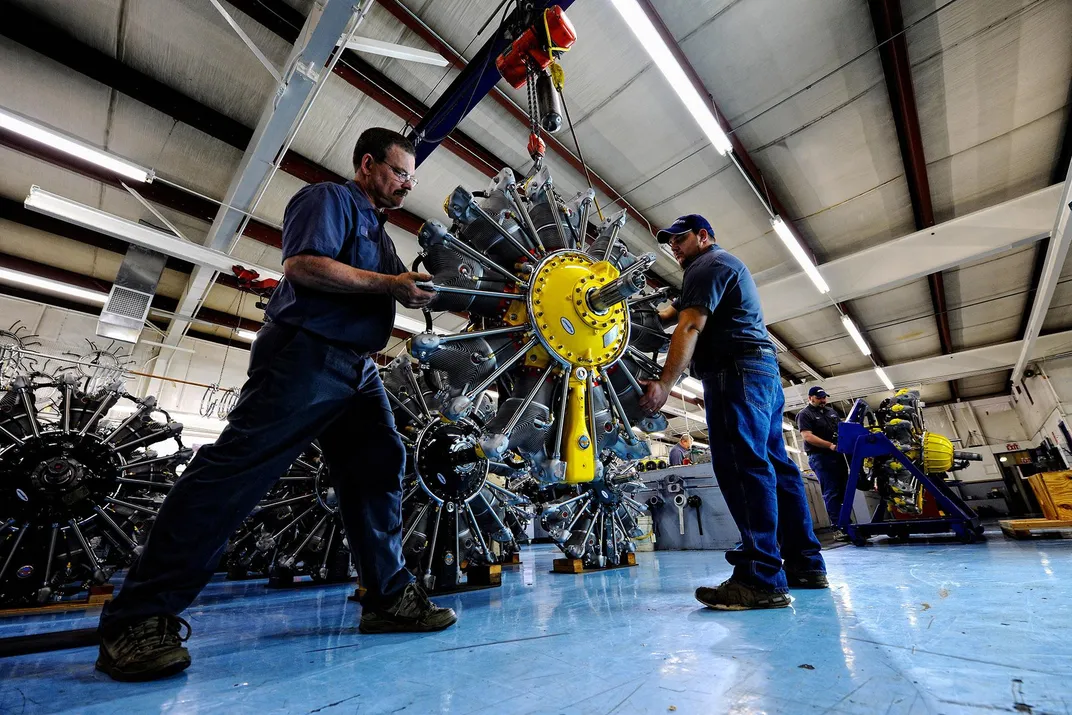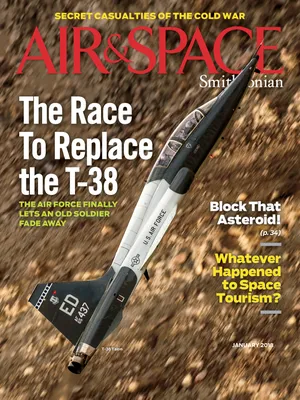Inside the Wasp Shop
These pilots and engineers caught the bug.
/https://tf-cmsv2-smithsonianmag-media.s3.amazonaws.com/filer/4a/23/4a23c0ff-6ff2-4e2d-8a2c-5edfc3d788e4/11o_aug2017_genemcneely_live.jpg)
Gene McNeely started flying airshows in 1986 and has been a stalwart presence on the AeroShell aerobatic team, flying a Wasp-powered North American T-6. He can only guess at his total flying time behind the engine: “I would say 15,000 hours…probably more than that.” He does remember exactly how he got there, though. “I got out of the Navy and…started cropdusting, and the first engine I sat behind was the [Pratt &Whitney R-]985, which we’d adapted to the Stearman,” he recalls.
McNeely later moved up to the Grumman Ag-Cat, with which “you could get whatever you wanted—the 985 or the [R-]1340—so we went with the 1340 ’cause we were hauling big loads in the rice country and it just made a miracle engine for cropdusting. That’s where I built most of my time.”
While dusting crops, McNeely was flying about 1,000 hours a year, and he says the Wasps worked hard. “We would actually run those engines [from dirt strips], 50 landings a day, and after about a thousand hours we would send ’em in [for overhaul].” When they got to about a thousand hours of “hard-time cropdusting…working off of dirt strips,” McNeely says, the microscopic grit that got into the engines would finally take its toll. “But the great thing is the Pratt & Whitney 1340 or the 985, it will tell the pilot, ‘Listen, I’ve got an issue. You need to do something about this’…. It will just start talking to you…. It would start skipping or beating or knocking, but it would keep running.”
Brian Norris is another well-known personality from the world of airshows, former operations coordinator and crew chief for Sean Tucker. About five years ago, he moved to an airport community in Florida called Spruce Creek, where Gene McNeely hangs his flight helmet, and the two became friends. One day he flew with McNeely in a Wasp-powered T-6. “That’s about all it took,” he says. “I was absolutely hooked after that. I mean, the whole airplane’s built like a tank, but that engine in particular is just awesome.”
Norris got most of his tutoring from McNeely. “Gene’s got the most crazy-looking tools that for years I’ve wondered what they’re for. And slowly I’m learning what each and every one of them does.”
Radial engines require different treatment before start-up too. When the airplane is parked for a while, oil flows down into the low cylinders, and if a cylinder fills with oil, hydrostatic lock can result. The remedy is to pull the prop blades through by hand. “You could bend a [connecting] rod, and that’s bad. And the rod, she’d probably come unglued on you in the air. So you pull [the propeller blades] through. That’s a part of living with a round engine.”
There are compensations:
Lou Churchville caught the Wasp bug while he was flying cropdusters as a contract pilot over the cotton fields of Sudan in the 1970s. Like the others, he learned to avoid abrupt throttle movement. “Power applications have to be smooth. You can’t sort of ram the throttle forward or pull it back real fast…. And the first time I flew one, I’ll never forget the noise…. It was just a roar.” After a while, though, the roar turned to music: “With the brakes locked, the airplane at full power static run-up, the roar changed to—I can only say a song.”

With time, Churchville heard more; he could hear the components of the engine. “I can hear different things working, and you know, I kind of imagined what they were in the engine…. If I felt something in the vibration or heard something embedded in this constant roar, that’s when I’d look at the instruments. Okay, what is it? What’s going on?”
At Covington Aircraft Engines in Okmulgee, Oklahoma—well known among the T-6 racing community—one of the warehouse-type buildings is dedicated to a sound-treated test cell where engines can be run up without disturbing the peace. Founder Bob Covington got approval from the Federal Aviation Administration to rebuild R-985s in 1972, and in 1975 turned the business over to employee Paul Abbott. Today, Abbott cousins, nephews, and in-laws make up a good portion of the total head count, but every worker in the company knows the Wasp inside out, and since it began, the company has grown dramatically. Covington is proof of the Wasp’s continuing popularity. “By the 1980s and ’90s,” Abbott says, “we were overhauling one engine every working day, 260 working days in a year, and still turning orders away.”
The workers are artisans, relying on a sense of touch and muscle memory to tell how much force to apply to a wrench so a bolt won’t break from over-torquing. There are racks of specialized tools they don’t sell at Sears, and at one workbench is the operation that made the Wasp a success: Here, a technician uses the force from a hydraulic pump to separate the two halves of the master connecting rod. The operation takes less than half a minute, but it’s this key design feature that keeps Covington in business and Wasps running on airplanes all over the world.
